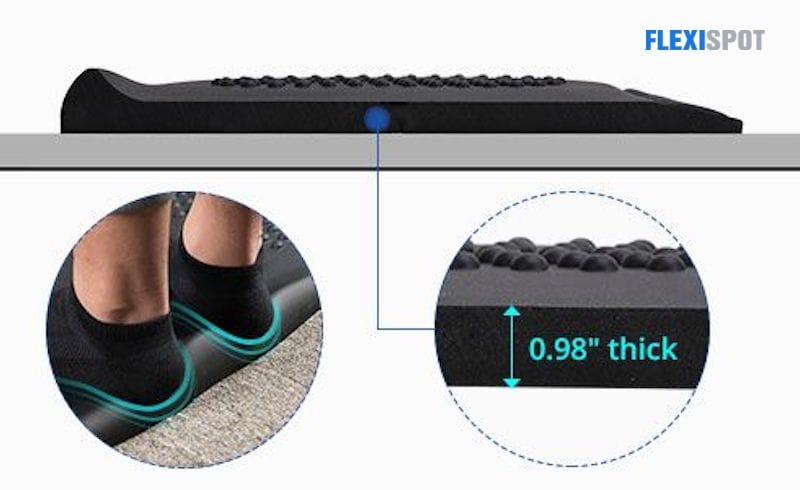Standing desks have taken up space in almost every ergonomic workstation—not only because it is trendy but more so because of the role it plays in making an employee more productive and efficient in his day-to-day line of work.
Because of its growing ubiquity, another problem has arisen. For centuries, there is a reason why we prefer to work while sitting down than standing up. Our 9 to 5 jobs simply won’t allow us to stand for that long of a period. At one point, it will hurt our feet or make our legs tensed even for a relatively short period of time. Many have come across this conundrum upon a few weeks of using their standing desks. Yes, it’s easy to adjust and switch back to sitting mode but there’s also a way to keep ourselves standing a little bit longer while we work.

Flexispot has recognized this and carries the DM1, an ergonomic anti-fatigue mat. Before we go into the features of the actual product, let’s discuss first what an anti-fatigue mat is anyway.
As the name suggests and according to the explanation provided by the Canadian Centre for Occupational Health and Safety (CCOHS), anti-fatigue mats are mats designed to reduce fatigue caused by standing for long periods on a hard surface. It is used to reduce discomfort, tiredness, and soreness in the lower body area including the feet, legs, knees, or hips while standing up for long hours.
It is important to note, however, that an anti-fatigue mat won’t solve everything. Fatigue in standing is also caused by other factors such as the quality of shoes and the floor covering. High-quality footwear has enough arch and heel support and cushioning. The hardness or softness of the flooring influences the feet; for instance, according to the CCOHS, walking on a hard floor can be likened to the impact of a hammer pounding the heel at every step.
Obviously, it’s not easy to change the flooring considering the cost, labor, and time it will take. Changing footwear can be an easier option but since working from home has become quite the norm in most companies and households, getting dressed in fancy footwear is not always the path taken by most people. Here enters the anti-fatigue mat. There aren’t many people who have been using it for a while so if you are considering buying one, make sure you know your needs; take into account its thickness and elasticity; and assess the workplace where you’ll be using it.
Trusted by global clients including big companies such as AOL, Google, Buzzfeed, Health Resources and Services Administration (HRSA), Bank of America, and IBM, Flexispot’s ergonomic anti-fatigue mat DM1 is definitely worth your consideration.
Caters to Dynamic Movements
It’s not just having fidgety feet. If you’re standing for a long time, you will of course move your feet and legs in various ways. The DM1 mat is sized with dimensions of 32.3” x 20.5 to give you ample space to move anytime you please or shift your weight from one foot to another. You also have the freedom to wear socks or shoes, whatever suits your fancy.
Constant Foot Massage
The DM1 mat is in a way able to read your feet’ movements because of its built-in massage points and mounds. It automatically stimulates the DM1 mat to massage your feet that will help wake them up, promote healthy blood circulation, and put you in a more relaxed physical and mental state.
Cushion and Maximum Comforts
The DM1 mat is 0.98 inches thick—it’s Flexispot’s most cushioned and comfortable anti-fatigue mat. Because of the thick cushion, the force of gravity is distributed and reduces the pressure on the feet. This is what enhances your comfort while standing up for long hours at work.
One issue with anti-fatigue mats is that they may cause accidents such as slipping and tumbling over. The Flexispot DM1 anti-fatigue mat has a no-skid design with a grooved skid-proof bottom that moves easily from sitting to standing. You may push your foot without the risk of slipping or skidding, the usual mat accidents that happen.
Is an Anti-Fatigue Mat Necessary?
In 2012, Loughborough University in England released a study on the significance of anti-fatigue mats with regards to the health of the employees. 14 participants joined the study and had to come to the laboratory at the same time each day. For five days, they stood on a concrete floor without a mat and on a concrete floor with an anti-fatigue mat for 90 minutes straight. Researchers used infrared thermal imaging, body temperature sensors, and infrared photographs to measure discomfort and fatigue.
Results showed that the participants experienced discomfort on their feet, legs, back, neck and shoulders. Standing for 90 minutes may even lead to serious, irreversible conditions. Good thing, according to the measurements, the anti-fatigue mats used in the study reduced the stress on the feet and legs that in the long run, could help curb the development of serious health concerns.
Leg muscles aid the heart in driving blood flow upward that helps the heart maintain normal blood pressure. If you stand with your feet firmly planted on a flat surface and the legs locked, the muscles are not able to perform efficiently, which increases the demand on the heart. Cushioning of the anti-fatigue mat will help disperse weight and absorb impact. Being able to shift from leg to leg eases discomfort.
Final Verdict
With all these into consideration, buying an anti-fatigue mat is necessary if you have shifted to using a standing desk and prefer to stand for long periods of time. An anti-fatigue mat will save you money for serious health concerns that may be caused by standing for long hours and will help reduce daily discomfort while working. The additional money is worth it if you look at the benefits it could do for your health and work efficiency.





